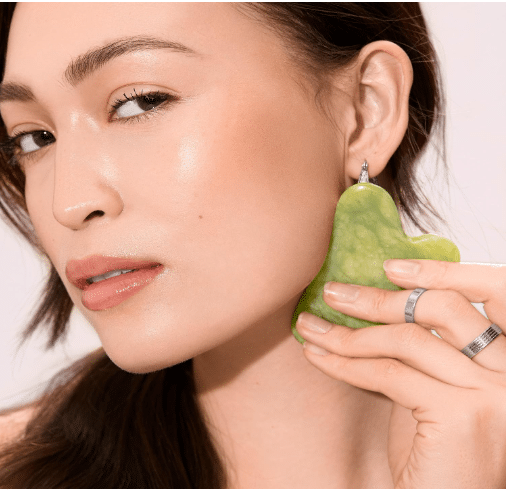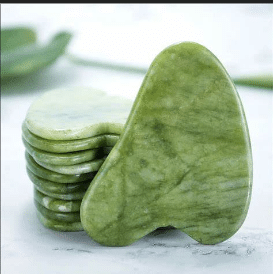Table of Contents
Introduction
In the realm of skincare, the Gua Sha stone has emerged as a revered tool known for its remarkable benefits in promoting healthy skin and combating signs of aging. Rooted in ancient Chinese medicine, this traditional technique has garnered attention in modern times for its ability to rejuvenate the skin and provide a natural anti-aging solution.
Guasha stone, an ancient healing tool originating from traditional Chinese medicine, has gained widespread recognition for its therapeutic benefits in recent years. This smooth-edged stone, typically made from jade, rose quartz, or bian stone, is utilized in a practice known as gua sha, which translates to “scraping away illness” in Chinese.
The technique involves gently scraping the skin’s surface with the guasha stone in specific rhythmic strokes, applied with varying degrees of pressure. This process aims to stimulate blood circulation, promote lymphatic drainage, and release tension held within the body’s muscles and fascia.
Beyond its physical benefits, guasha is revered for its ability to alleviate pain, reduce inflammation, and revitalize the body’s natural energy flow, known as Qi. Moreover, its application extends beyond traditional Chinese medicine, finding its place in modern wellness practices, beauty routines, and holistic therapies.
The growing popularity of guasha stone is attributed to its non-invasive nature and potential to provide relaxation, improve skin appearance, and contribute to overall well-being. As more individuals seek natural and holistic approaches to health and beauty, the guasha stone continues to captivate enthusiasts worldwide for its time-honored therapeutic properties.

What is Gua Sha?
Gua Sha, pronounced “gwasha,” translates to “scraping” in Chinese. It involves gently scraping a smooth-edged tool, often made of jade or rose quartz, along the skin in upward strokes to stimulate circulation and promote lymphatic drainage. The technique aims to relieve muscle tension, reduce puffiness, and encourage the body’s natural detoxification process.

Guasha Stone Using Technique
Guasha, also known as Gua Sha, is a traditional Chinese healing technique that involves scraping the skin with a smooth-edged tool, typically a stone, to improve circulation and promote healing. Here’s a step-by-step guide on how to use a guasha stone:
- Choose the right tool. Select a guasha stone made from jade, rose quartz, or another smooth-edged stone specifically designed for this purpose. Ensure the edges are not too sharp to avoid injuring the skin.
- Preparation: Apply a generous amount of oil or lotion to the area you want to treat. This helps the stone glide smoothly on the skin, reducing friction and preventing irritation.
- Hold the Stone: Hold the guasha stone at a 15- to 45-degree angle to your skin. Start with gentle pressure to gauge your comfort level. The pressure should be firm enough to feel a slight pulling sensation but not so hard that it causes pain.

- Direction: Use gentle but firm strokes in one direction. Traditionally, strokes are made in an upward and outward direction, following the muscle lines and moving away from the center of the body. You can use long or short strokes based on the area you’re treating.
- Technique: Move the guasha stone with consistent pressure across the skin, keeping it flat against the surface. Repeat each stroke in the same direction 5–10 times before moving to another area.
- Be Gentle: Avoid scraping over bony areas, sensitive skin, or areas with cuts, bruises, or sunburn. Also, be cautious around delicate areas like the face.
- Follow a Pattern: You can follow a specific pattern or sequence while performing guasha, like starting from the neck and moving down towards the shoulders, then across the back in sections.
- Cleanse the Stone: After each use, clean the guasha stone with soap and water to prevent the buildup of oils or residues.
- Hydrate Afterward: Once you’re finished, apply a soothing lotion or moisturizer to the treated area to keep the skin hydrated.
- Frequency: Guasha can be done 2-3 times a week or as needed. However, avoid excessive scraping, as it may cause skin irritation.
Always remember that while guasha can provide various benefits, it’s essential to be gentle and mindful of your skin’s sensitivity. If you have any underlying skin conditions or concerns, it’s wise to consult with a healthcare professional before practicing guasha.

Benefits of Skincare and Anti-Aging:
Enhanced Circulation:
One of the primary advantages of Gua Sha is its ability to boost blood circulation. Improved blood flow means increased oxygen and nutrient delivery to the skin, resulting in a healthier complexion and a radiant glow.
Lymphatic Drainage:
Gua Sha aids in lymphatic drainage, helping to flush out toxins and reduce puffiness. This reduces the appearance of under-eye bags and facial bloating, creating a more sculpted and toned facial contour.
Reduced Wrinkles and Fine Lines: Regular use of Gua Sha can diminish the appearance of fine lines and wrinkles. By stimulating collagen production and promoting elasticity, it contributes to a smoother, firmer skin texture.
Relief from Tension and Stress:
The gentle massaging motions of Gua Sha can alleviate facial muscle tension, easing stress-related expressions and relaxing the facial muscles for a more youthful appearance.
Advantages:
- Natural and Non-Invasive: Gua Sha offers a natural way to improve skin health without invasive procedures or harsh chemicals.
- Cost-effective: Once you own a Gua Sha stone, it’s a one-time purchase with no need for recurring expenses.
- Versatility: It can be used on various parts of the body, not just the face, for overall relaxation and wellness.
Disadvantages:
Requires Consistency:
To see noticeable results, regular and consistent use of Gua Sha is necessary, which might be time-consuming for some.
Risk of Bruising:
Improper technique or excessive pressure can lead to bruising or skin irritation, so proper instruction or professional guidance is advisable.

FAQs about GuaSha:
Q: Can Gua Sha cause discomfort?
A: When done correctly, Gua Sha should not cause discomfort. However, applying too much pressure or using the wrong technique might lead to discomfort or bruising.
Q: How often should I use Gua Sha?
A: For optimal results, using Gua Sha 2-3 times a week is recommended. However, individual skin types may vary, so adjust according to your skin’s response.
Q: Is Gua Sha suitable for all skin types?
A: Generally, Gua Sha is suitable for most skin types, but those with highly sensitive or inflamed skin should consult a dermatologist before use.
Conclusion
Gua Sha is a time-honored practice that continues to weave into modern skincare routines. When used correctly, its benefits for skincare and anti-aging make it a valuable tool for promoting healthy, youthful skin. However, proper technique and consistency are crucial to harnessing its full potential while avoiding any adverse effects.
Remember, before incorporating any new skincare tool or technique into your routine, it’s wise to consult with a skincare professional or dermatologist to ensure it aligns with your skin’s specific needs and conditions.
